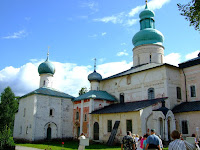 Our next stop was not scheduled until mid afternoon so we were entertained by part two of a very informative History Channel series Russia - the Land of the Tsars and then a tour of the bridge of the ship which, the Captain told us, was built in 1985.
Our next stop was not scheduled until mid afternoon so we were entertained by part two of a very informative History Channel series Russia - the Land of the Tsars and then a tour of the bridge of the ship which, the Captain told us, was built in 1985.The Russia – the Land of the Tsars series was played over 4 days and was an extremely interesting and informative program that gave a good grounding in the history of Russia and which, most of us acknowledged, filled in the lamentable gaps in our education.
 At 2 p.m. the ship berthed at Goritsy a very small village, with a Nunnery, built on the shore of the White Lake, but that was not the purpose of our stop. We boarded a shuttle bus that took us to a nearby town that is built around the Kirillo-Belozersky monastery, the largest in Europe. The complex covers more than 10 hectares with its longest wall over 2 km.
At 2 p.m. the ship berthed at Goritsy a very small village, with a Nunnery, built on the shore of the White Lake, but that was not the purpose of our stop. We boarded a shuttle bus that took us to a nearby town that is built around the Kirillo-Belozersky monastery, the largest in Europe. The complex covers more than 10 hectares with its longest wall over 2 km.  In 1397 Kirill the monk, then aged 60, walked the 500 km from Moscow to found this monastery at a place that that been revealed to him in a vision and although the thousands of hectares that once belonged to the monastery were confiscated by Catherine the Great the central buildings still stand as part museum, part monastery - now home to just three monks.
In 1397 Kirill the monk, then aged 60, walked the 500 km from Moscow to found this monastery at a place that that been revealed to him in a vision and although the thousands of hectares that once belonged to the monastery were confiscated by Catherine the Great the central buildings still stand as part museum, part monastery - now home to just three monks.Amazingly the iconostasis survived the Soviet regime and while the main church is undergoing restoration a number of the icons from the iconostasis are displayed in the museum on site alongside others from different parts of Russia.





No comments:
Post a Comment